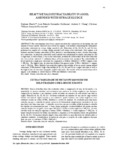Use este identificador para citar ou linkar para este item:
http://www.alice.cnptia.embrapa.br/alice/handle/doc/573324Registro completo de metadados
| Campo DC | Valor | Idioma |
|---|---|---|
| dc.contributor.author | MARCHI, G. | pt_BR |
| dc.contributor.author | GUILHERME, L. R. G. | pt_BR |
| dc.contributor.author | CHANG, A. C. | pt_BR |
| dc.contributor.author | NASCIMENTO, C. W. A. do | pt_BR |
| dc.date.accessioned | 2011-04-10T11:11:11Z | pt_BR |
| dc.date.available | 2011-04-10T11:11:11Z | pt_BR |
| dc.date.created | 2009-10-27 | pt_BR |
| dc.date.issued | 2009 | pt_BR |
| dc.identifier.citation | Sci. Agric. (Piracicaba, Braz.), v. 66, n. 5, p. 643-649, sep./oct. 2009 | pt_BR |
| dc.identifier.uri | http://www.alice.cnptia.embrapa.br/alice/handle/doc/573324 | pt_BR |
| dc.description | Few investigations have been carried out about the comparison of desorption rate and amount of heavy metals extracted successively by organic acid mixtures mimicking the rhizosphere and routine extractants in sewage sludge-amended soils. Extractions of Zn, Cd, Ni, Cr, and Cu were performed in samples of a sewage sludge-amended soil using seven extractants: four organic acid mixtures and three routine extractants (DTPA, Mehlich-I, and ammonium acetate). Results from single pass extractions, in which the extractable metal contents were determined by simply extracting the soil a single time, as well as from 15 successive extractions, in which the solid residues of the first extraction was successively extracted 14 additional times, of heavy metals were analyzed. The extractability of heavy metals in a single pass extraction was, in general, as follows: Mehlich-I > DTPA > organic acids > NH4OAc. The highest rates of extraction followed the general order: DTPA > Mehlich-I > organic acids > NH4OAc. While Mehlich-I presented the highest extractability of heavy metals among studied extractants, DTPA showed a high extractability of Zn, Cd, Ni, and Cu in a single extraction as well as the highest rates of extraction among the studied extractants. The transfer of heavy metals from soil to organic acid solutions is slower than to DTPA and Mehlich-I extractants. | pt_BR |
| dc.language.iso | eng | eng |
| dc.rights | openAccess | eng |
| dc.subject | Lodo de esgoto | pt_BR |
| dc.subject | Latossol | pt_BR |
| dc.subject | Heavy Metal | pt_BR |
| dc.title | Heavy metals extractability in a soil amended with sewage sludge. | pt_BR |
| dc.type | Artigo de periódico | pt_BR |
| dc.date.updated | 2013-11-07T11:11:11Z | pt_BR |
| dc.subject.thesagro | Latossolo | pt_BR |
| dc.subject.thesagro | Extração | pt_BR |
| dc.subject.thesagro | Metal Pesado | pt_BR |
| dc.subject.nalthesaurus | extraction | pt_BR |
| dc.subject.nalthesaurus | sludge | pt_BR |
| dc.format.extent2 | 643-649 | pt_BR |
| riaa.ainfo.id | 573324 | pt_BR |
| riaa.ainfo.lastupdate | 2013-11-07 | pt_BR |
| dc.identifier.doi | 10.1590/S0103-90162009000500009 | pt_BR |
| dc.contributor.institution | GIULIANO MARCHI, CPAC; Luiz Roberto Guimarães Guilherme, UFLA; Andrew C. Chang, University of California; Clístenes Williams Araújo do Nascimento, UFRPE. | pt_BR |
| Aparece nas coleções: | Artigo em periódico indexado (CPAC)  | |
Arquivos associados a este item:
| Arquivo | Descrição | Tamanho | Formato | |
|---|---|---|---|---|
| marchig012009.pdf | 191,5 kB | Adobe PDF |  Visualizar/Abrir |









